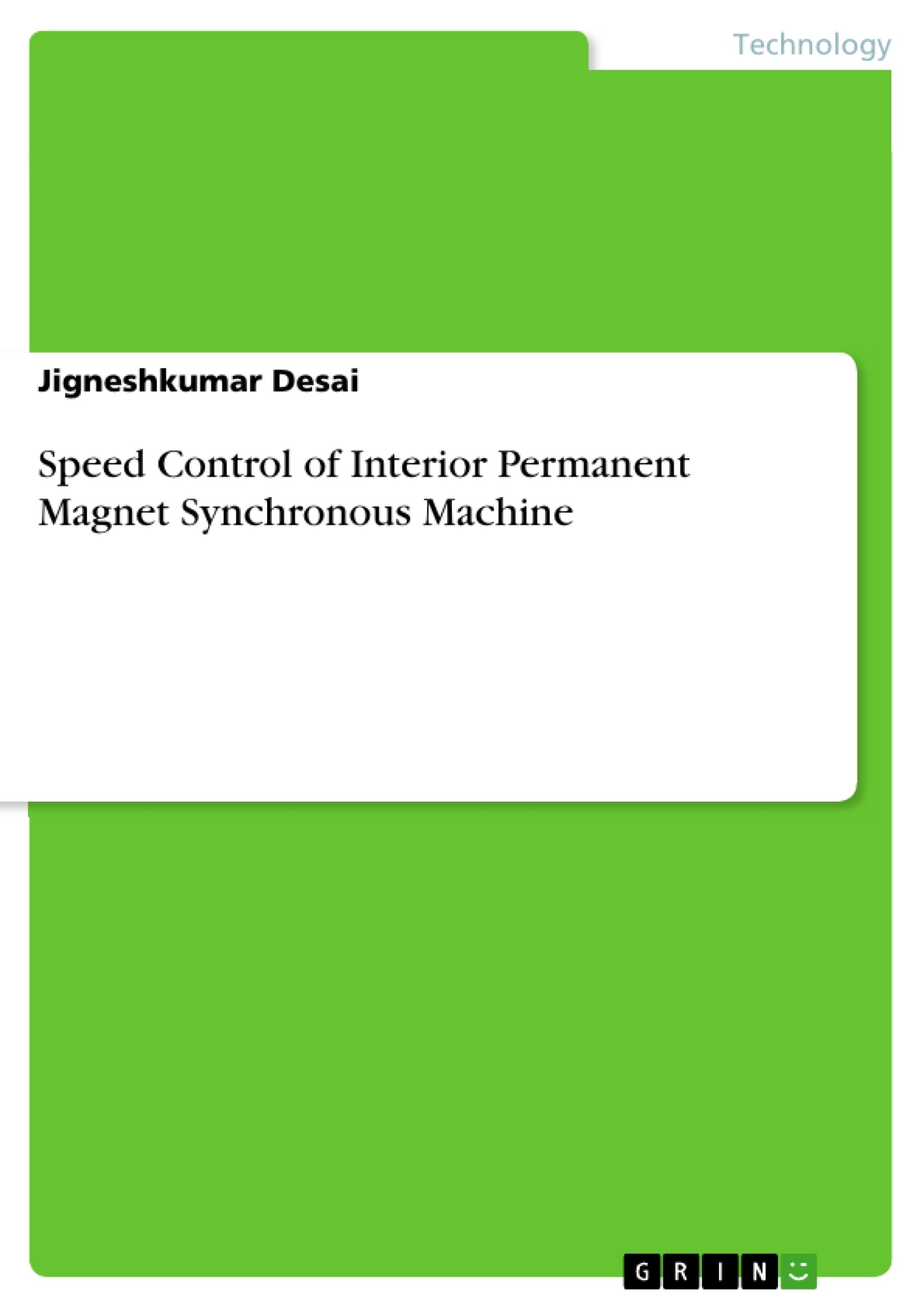The creation of a simulation model for closed loop vector controlled IPMSM drive performance enhancement and speed control is described in this book. By regulating the torque component of the current, the model achieves superior speed tracking and rapid dynamic response under transient and steady-state circumstances. The control technique is used by both the proportional and integrated controllers in the PI controller. Combining two independent controllers and reducing the shortcomings of each results in a more effective controller. To offer optimal speed operation in the face of environmental changes, load variations, and structural disturbances, the Fuzzy Logic Controller for PMSM must be properly constructed. Using MATLAB Simulink, this book gives a comprehensive simulation of an internal permanent magnet synchronous motor driving system.
Interior permanent magnet synchronous motors (IPMSMs) are used to improve machine performance and offer rapid torque response. IPMSMs are utilised in low and medium-power applications such as servos, robotics, variable-speed motors, electric vehicles, and computer peripherals. Because PM motor drives are becoming more popular, simulation systems capable of handling motor drive simulations are in great demand. Simulation tools can dynamically simulate motor drives in a visual environment, saving money and time and easing the development of new systems.
Inhaltsverzeichnis (Table of Contents)
- Abstract
- Chapter 1: Introduction to Electric Vehicle
- 1.1.1 Challenges in EV
- 1.2 Permanent magnet synchronous motor (PMSM)
- 1.2.1 Principle of the PMSM
- 1.2.2 Mathematical Model of PMSM
- 1.2.3 Advantages of PMSM
- Chapter 2: History and Literature Review
- 2.1 History
- 2.1.1 Electric Vehicle and Government
- 2.1.2 The Advent of Electric Vehicles: Electric Cars
- 2.1.3 The Future of Electric Cars in India
- 2.2 Literature Review
- 2.1 History
- Chapter 3: Control schemes for PMSM
- 3.1 Scalar control
- 3.1.1 Volts/Hertz control
- 3.2 Vector control
- 3.2.1 Field Oriented Control
- 3.2.2 Direct Torque Control
- 3.2.3 Direct SelfControl
- 3.2.4 DTC-Space Vector Modulation
- 3.3 Methods to Control the PMSM
- 3.3.1 Using PI Controller
- 3.3.2 Using Fuzzy Logic Controller
- 3.1 Scalar control
- Chapter 4: Direct Torque Control of PMSM
- 4.1 Block Diagram of Direct Torque Control
- 4.1.1 Current Transform
- 4.1.2 Flux Estimator
- 4.1.3 Sector Calculation
- 4.1.4 Torque Calculation
- 4.1.5 Torque and flux hysteresis comparators
- 4.1.6 Look-up Table
- 4.1.7 Voltage Source Inverter
- 4.2 Some problems with the Direct Torque Control
- 4.2.1 Torque ripple
- 4.2.2 Drift in Flux Estimator
- 4.3 DTC of PMSM using PI Controller
- 4.3.1 MATLAB implementation
- 4.3.2 Results of 3.75 KW (5 Hp) IPMSM
- 4.1 Block Diagram of Direct Torque Control
- Chapter 5: Field Oriented Control of PMSM using PI Controller
- 5.1 Field Oriented Control
- 5.1.1 Transformations
- 5.1 Field Oriented Control
- Chapter 6: Field Oriented Control of PMSM using Fuzzy Logic Controller
- 6.1 Fuzzy Logic Controller
- 6.2 Basic Control Structure of PMSM using FLC
- 6.2.1 Fuzzy Logic Controller for Speed Control of PMSM
- Chapter 7: Results and Discussion
- 7.1 Modeling of Speed Control of IPMSM
- 7.2 Machine modeling parameters
- 7.3 Program file
- 7.3.1 Membership function of Fuzzy Logic
- 7.4 Speed control outputs
- Chapter 8: Conclusion and Future Scope
Zielsetzung und Themenschwerpunkte (Objectives and Key Themes)
This thesis focuses on the development of a simulation model for closed-loop vector controlled IPMSM drive performance enhancement and speed control. The goal is to improve the speed tracking and dynamic response of the drive system during transient and steady-state conditions by controlling the torque component of the current. Key themes covered include:- Simulation modeling of IPMSM drive systems
- Closed-loop vector control strategies
- Performance enhancement through torque control
- Speed control using both PI and fuzzy logic controllers
- Comparison of controller performance and implementation in MATLAB Simulink
Zusammenfassung der Kapitel (Chapter Summaries)
- Chapter 1: Provides an introduction to electric vehicles, highlighting the challenges faced in their development and adoption. The chapter also introduces the permanent magnet synchronous motor (PMSM), outlining its principles, mathematical model, and advantages.
- Chapter 2: Traces the history of electric vehicles, focusing on their development and government involvement. It also presents a literature review of the relevant research and advancements in the field.
- Chapter 3: Discusses various control schemes for PMSMs, including scalar control, vector control, and different methods to control the motor using PI controllers and fuzzy logic controllers.
- Chapter 4: Delves into the direct torque control (DTC) of PMSMs, explaining the block diagram, its components, and potential problems associated with DTC. The chapter also discusses the implementation of DTC using a PI controller in MATLAB.
- Chapter 5: Explains the field-oriented control (FOC) of PMSMs, detailing its implementation using a PI controller and the necessary transformations involved.
- Chapter 6: Explores the use of fuzzy logic controllers for FOC of PMSMs. It discusses the basic control structure, the implementation of a fuzzy logic controller for speed control, and the general structure of a fuzzy logic controller.
- Chapter 7: Presents the results and discussion of the simulation model for speed control of IPMSM. This chapter covers the modeling of the system, machine parameters, program file, membership function of fuzzy logic, and speed control outputs.
Schlüsselwörter (Keywords)
The primary focus of this thesis is on the performance enhancement and speed control of Interior Permanent Magnet Synchronous Motors (IPMSM) for electric vehicle applications. Key concepts include vector control strategies, simulation modeling, PI controllers, fuzzy logic controllers, torque control, speed tracking, and dynamic response analysis. The work investigates and compares the effectiveness of different control methods, aiming to optimize IPMSM performance for efficient electric vehicle operation.- Quote paper
- Jigneshkumar Desai (Author), 2022, Speed Control of Interior Permanent Magnet Synchronous Machine, Munich, GRIN Verlag, https://www.grin.com/document/1277472



